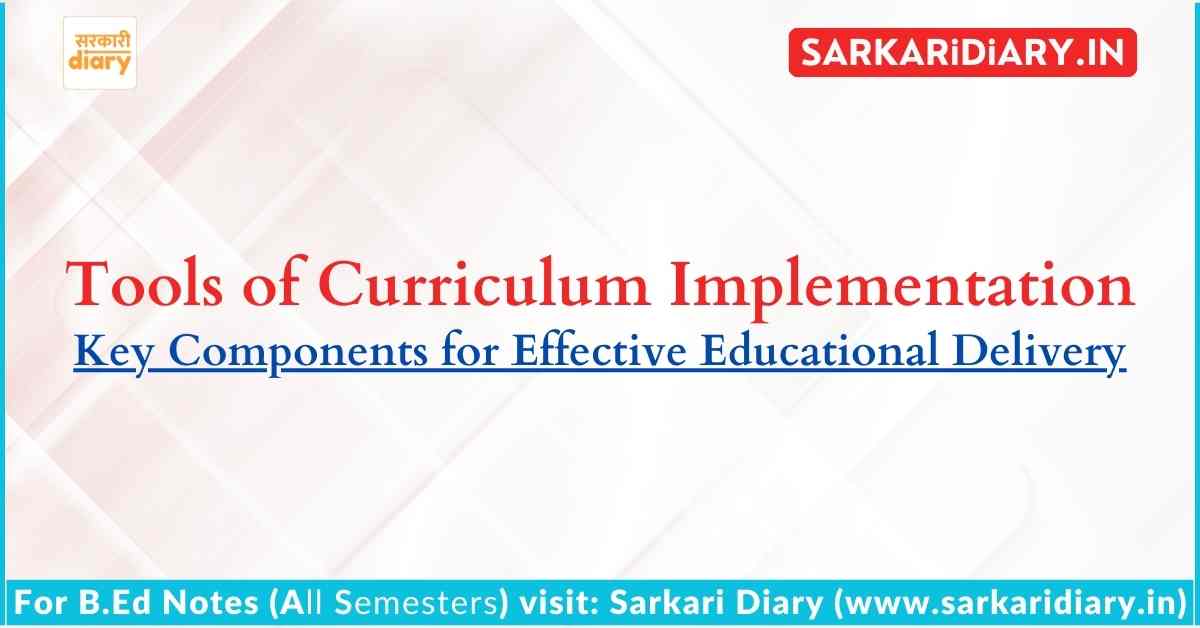Implementing a curriculum effectively requires not only sound design but also robust tools that ensure accuracy, accessibility, cultural sensitivity, and measurable outcomes. These tools must be holistic in nature—covering content, audience, readability, utility, and evaluation.
The following framework outlines the essential components of curriculum implementation tools, guiding educators, curriculum developers, and policymakers in ensuring quality education delivery.

Content-Based Components
To ensure credibility and instructional integrity, the curriculum must be grounded in strong academic and theoretical foundations.
| Theoretical Foundation | Curriculum should be rooted in current educational and behavioural theories. |
| Research-Based Content | Content must be accurate, current, and supported by evidence or academic research. |
| Balanced Viewpoint | Should reflect multiple perspectives, especially on debated or evolving topics. |
| Learning Objectives | Clear, measurable outcomes aligned with the curriculum’s theoretical framework. |
Audience-Centric Considerations
Understanding and engaging the target audience is critical for impactful learning experiences.
Audience Engagement Tools
| Target Audience | Content is tailored to suit the needs and characteristics of the intended learners. |
| Audience Input | Development guided by learner needs, interests, and cultural context. |
| Audience Involvement | Encourages participation and fosters behavioural change. |
| Reflection of Diversity | Accommodates cultural, linguistic, and literacy diversity. |
| Respect for Diversity | Respects socio-cultural identities and ensures inclusivity. |
Readability and Presentation
To ensure comprehension and accessibility, curriculum tools should adhere to plain language principles and be appropriately structured.
Readability Standards
| Grammar & Mechanics | Written in standard English with correct grammar, spelling, and punctuation. |
| Tone and Terminology | Uses clear language; health/technical terms are explained or simplified. |
| Reading Level | Ideally written at Class VI level for public-facing content. |
| Organisation | Content is logically sequenced and easy to follow. |
| Material Style | Layout considers font size, visuals, colours, and format to aid understanding. |
Utility and Practical Use
Effective curriculum tools are designed to be easily implemented by educators and support classroom delivery through practical aids.
Practical Utility Elements
| Lesson Preparation | Includes lesson plans, prep guides, and support material lists. |
| References and Citations | Credible sources and references clearly acknowledged. |
| User Instructions | Clear and concise implementation guidelines. |
| Program Validity | Curriculum must be peer-reviewed, pilot-tested, and refined. |
| Educational Activities | Activities are feasible, relevant, and support learning outcomes. |
| Additional Resources | Multimedia tools, websites, and supplementary materials provided. |
| Logic Model | Includes planning tools like a logic model or outcome framework. |
| Implementation Process | Clearly outlines the recommended process for effective delivery. |
Evaluation and Assessment Tools
Evaluation tools are essential for measuring learning outcomes, monitoring progress, and ensuring continuous improvement.
Evaluation Components
| Audience-Tested Instruments | Assessment tools validated through feedback from the target group. |
| Psychometric Soundness | Tools demonstrate reliability and validity. |
| Learning Objective Alignment | Evaluation methods are directly linked to learning and behavioural objectives. |
| Evaluation Phases | Tools assess effectiveness before, during, and after implementation. |
Conclusion
Effective curriculum implementation hinges on a well-integrated framework that considers not just what is taught, but how, to whom, and with what outcomes. The tools outlined above offer a comprehensive approach to evaluate and enhance the quality, accessibility, and effectiveness of any educational programme.
By addressing aspects such as theoretical relevance, inclusivity, practical utility, and rigorous evaluation, curriculum developers and educators can create meaningful learning experiences that drive real behavioural and academic change.